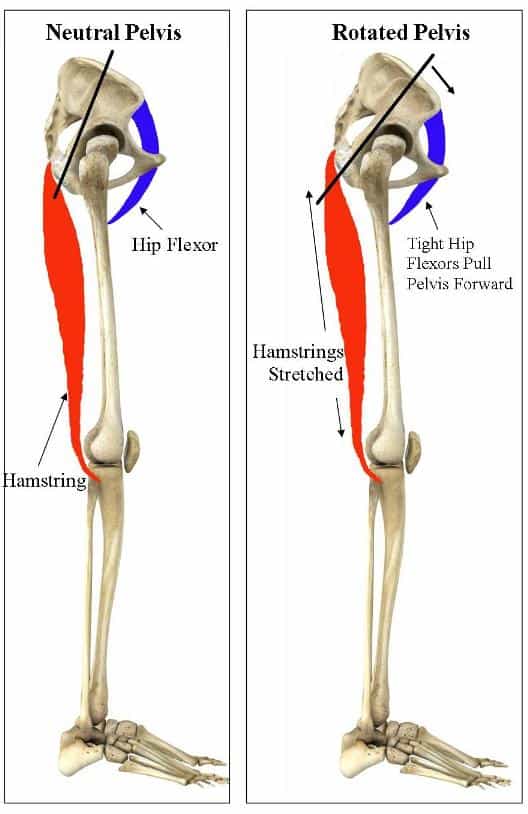
Hamstrings (Pt 1) – Getting Knee Extension
Chronically tight muscles don’t get resolved from mere stretching. Most often, there’s a positional issue at the attachments keeping the muscle in a lengthened position. For the hamstrings, look at the pelvis. If it’s stuck in anterior tilt, like many of us are, the hamstrings are stuck in a similar state of tension.
 |
| photo credit: movement-as-medicine.com |
Step One, then, is to get the pelvis out of anterior tilt.
Step Two would be to integrate this pelvic/ abdominal control into a leg raising and lowering pattern. Why one leg at a time? Because it’s how we locomote. A large chunk of the population has a stable leg and a mobile leg. (If you tend to ‘rest’ on one hip or with one leg out to the side, THAT is your stable leg. It’s been programmed to do most of the ‘holding you up’ while your other leg MOVES around it). The asymmetrical leg raise (or ASLR) tests which leg is has more mobility.
 |
| photo credit: functional-training-magazin.de |
Here’s the test, followed by two corrections, turbo instagram style:
We’re looking for asymmetries here.
Press down on the floor leg. If something lifts up something else must press down.
2.The foot slides attempt to use the surface as a hip/pelvic stabilizer to let the hamstrings release.
Try and get the butt as close to the rack/ door jam as possible.
3. The leg lowers reverse the movement – it’s easier working with gravity than against.
The point here is to control the pelvis (keep the low back on the floor) and hip (don’t let it rotate) on the descent. You should only feel this in your lower abs. If you feel it in the quads/hip flexor, lift the leg back up. Elevate the floor if need be, by lowering the leg to a towel or roller.
“Crunch” the weight vertical, lifting both shoulders off the ground evenly.
(This is not a rotational punch).
Again, drive DOWN on the floor leg, trying to keep the calf on the ground.
Once control has been mastered, take the leg raise to the feet or standing.
You can also invert the position into a hinge, extending the standing knee.
All other variables aside, knee extension has the highest demand when the hip is maximally flexed.
You can isolate the hamstring in this wonderful move from Dewey Nielsen. In it, he offers the regression of “lowering the ball to the hip” or using a bigger ball.
Here’s my exploratory take, trying to achieve the same movement without torso support:
Hands off floor = core tension (to hold you up) = conflicting focus = harder limb control
TO REVIEW:
- Chronic tightness is typically a positioning and/or motor control issue.
- For tight hamstrings, first check the pelvis
- A large majority of hip dysfunction comes from having a stable leg and a mobile leg
- The ASLR and it’s correctives attempt to practice both stability AND mobility. The legs/hips should retain the ability to do BOTH. (Walking is an example of this balanced need.)
- The standing leg raise and single leg wall reach are upright versions of the ASLR
- Knee extension is a result of quad contraction and hamstring control (release, but also press).
- Hamstring control is most concentrated when the hip is maximally flexed and you don’t need to focus on the balance of standing/ holding yourself up right



